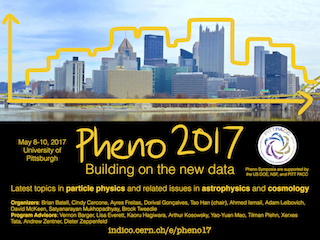Mini-review: Supersymmetry phenomenology at the LHC
In this talk an overview of the recent CMS searches for supersymmetry in fully hadronic final states will be presented. These searches were performed using 36\fb of pp collision data at 13 TeV, collected during 2016. The results provide the strongest limits to date on the masses of pair-produced squarks and gluinos.
Despite the absence of experimental evidence, weak scale supersymmetry remains one of the best motivated and studied Standard Model extensions. This talk summarises recent ATLAS results on inclusive searches for supersymmetric squarks and gluinos, including third generation squarks produced in the decay of gluinos. The searches involve final states containing jets, missing transverse momentum...
Radiatively-driven natural SUSY (RNS) models enjoy electroweak
naturalness at the 10\% level while respecting LHC sparticle and Higgs
mass constraints. Gluino and top squark masses can range up to several
TeV (with other squarks even heavier) but a set of light Higgsinos are
required with mass not too far above $m_h\sim 125$ GeV. Within the RNS
framework, gluinos dominantly decay via...
Supersymmetric theories offer an elegant solution to the naturalness problem of the Standard Model Higgs, constraining the mass of the superpartners of the third generation quarks, the stop and the sbottom, to be below the TeV scale. This talk presents the status of the ATLAS searches for direct pair production of third generation squarks. It presents an overview of the latest public analyses...
Naturalness arguments for weak-scale supersymmetry prefer the superpartners of
the third generation quarks (stop and sbottom) with masses close to the
electroweak scale, which can be produced at the LHC. This talk presents recent
CMS results from searches for direct stop and sbottom pair production, using
data collected in proton-proton collisions, at a center-of-mass energy of 13
TeV,...
The Higgs pair production in gluon fusion is a sensitive probe of beyond-Standard Model (BSM) phenomena. Motivated by the combined analysis of ATLAS and CMS Higgs production data, which allows moderate deviations of the Higgs couplings with respect to their Standard Model (SM) values, we show that the Higgs pair production may be significantly increased with respect to the SM predictions in a...
